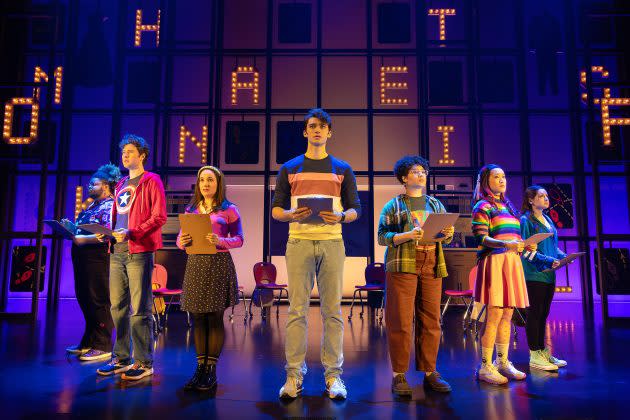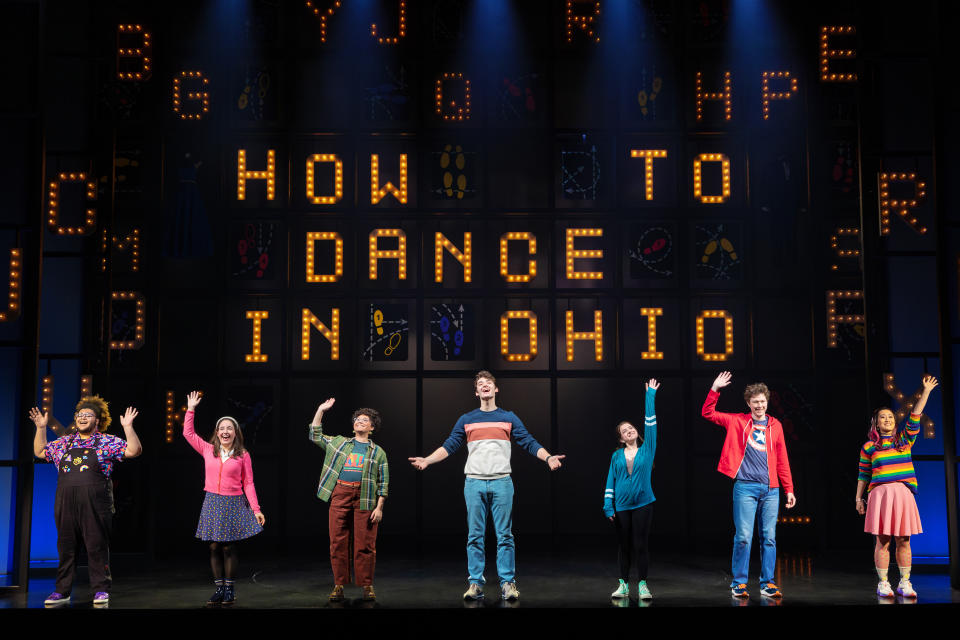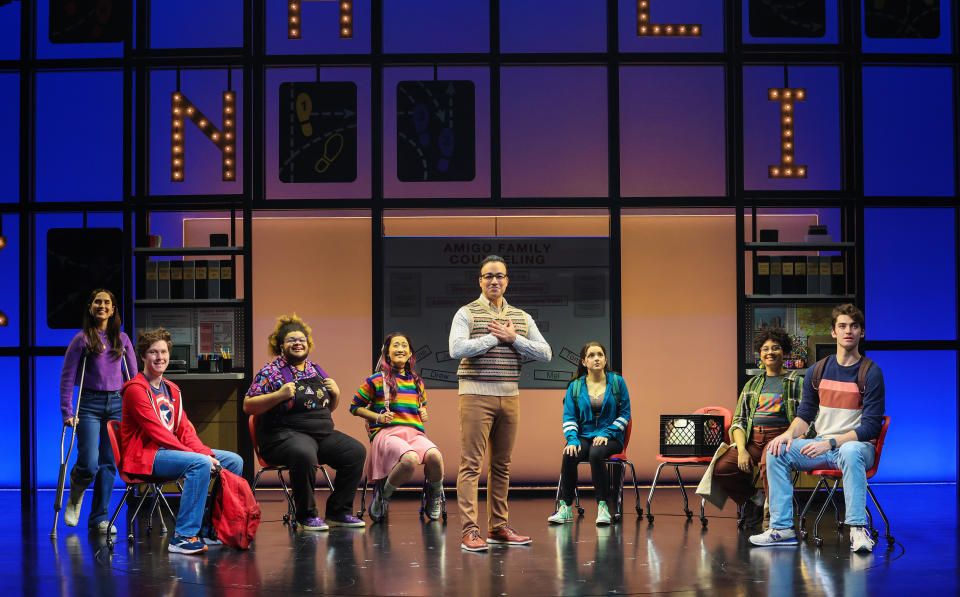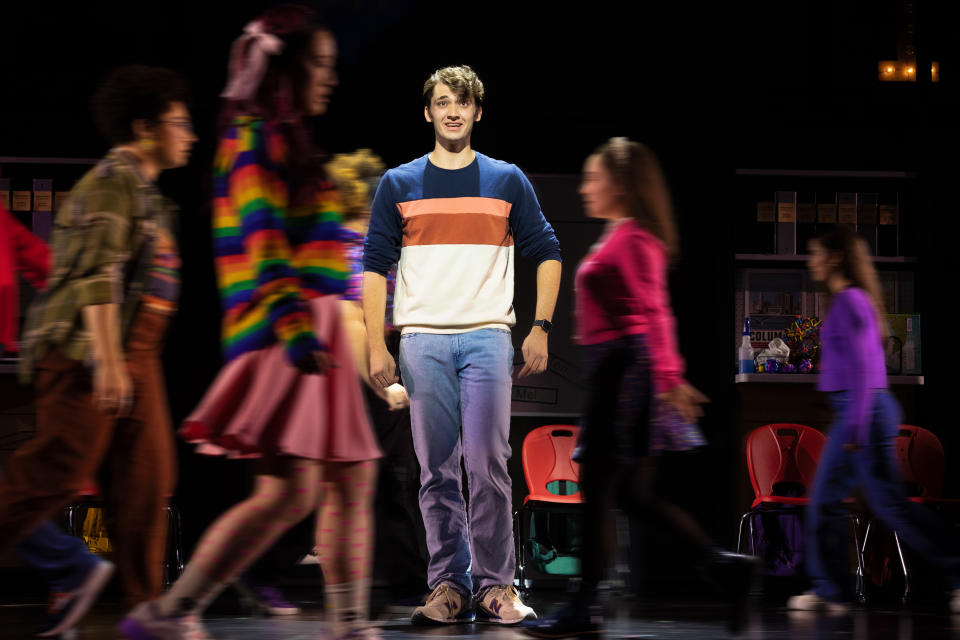‘How To Dance In Ohio’ Review: Broadway’s First Autistic Cast Has All The Right Moves In A Musical That Sometimes Doesn’t
- Oops!Something went wrong.Please try again later.

Not since the perfect (what other word is there?) Kimberly Akimbo first made us laugh and bent our hearts two years ago has a stageful of youthful characters so inspired our best, heartfelt wishes as those learning how to dance in Ohio in the new musical of that very name. Based on the affecting, same-titled 2015 HBO documentary, the new Broadway musical How To Dance In Ohio, opening tonight at the Belasco Theatre, is chock-full of thoroughly endearing young people – the fictional ones and their portrayers – that have us rooting for them from start to finish.
From the opening, pre-plot moment when the cast of seven young (mostly 20s) autistic persons takes the stage to directly introduce themselves and establish some background (“There’s a saying, ‘If you’ve met one autistic person… you’ve met one autistic person,” says actor Conor Tague. “You are now meeting seven autistic people.”), their enthusiasm has our hearts. When they slip into their characters seconds later, their charming performances seal the deal: We want this show to soar.
More from Deadline
‘Heartstopper’ Star Joe Locke To Make Broadway Debut In Hit ‘Sweeney Todd’
‘Kimberly Akimbo’ Broadway Review: Growing Up And Growing Old In A Musical Stunner
2023-24 Awards Season Calendar - Dates For Oscars, Emmys, Grammys, Tonys, Guilds & More

That it doesn’t is a disappointment softened only by the experience of seeing a group of Broadway newcomers get so thrillingly close to something like flight, and suspecting that this won’t be the last time they’ll have the opportunity.
Inspired by Alexandra Shiva’s Peabody Award-winning 2015 HBO documentary of the same name, How To Dance In Ohio employs stage musical convention – the book and lyrics are by Rebekah Greer Melocik, music by Jacob Yandura, choreography by Mayte Natalio and direction by Sammi Cannold, all making their Broadway debuts – to present a groundbreaking concept: A slate of characters with autism portrayed by a cast of actors with autism.
Based on actual events, How To Dance In Ohio tells the story of a support group of and for autistic young adults in Columbus, Ohio (the city is never actually specified, but references to a college rivalry with Michigan gives it away). As in real life, the group is run by the kindly and supportive Dr. Amigo – sometimes the world hands dramatists little gifts – and the goal is to help the teens and twentysomethings take the next steps in their journeys toward independence and social engagement.
With some of what Amigo calls his clients making college plans, the doctor has an idea: Why not turn these next steps into dance steps? Sensing that the word “prom” comes too fully loaded with expectation, he simply proposes to the young people that the group should plan a spring formal to celebrate a year-end milestone.
Even with the euphemistic name, the prospect of a dance engenders considerable anxiety for these young people who have never found the words to ask for a date, who have never coordinated their feet into anything resembling so much as a two-step, and who, as Tague’s Tommy says in a tone approaching panic, will require a shirt with a collar. Just the thought of a collared shirt causes Tommy stress, and he wonders if the dance is meant as a punishment. “Because it feels like a punishment,” he says accusingly.
Later, Tommy sings, “Having flashbacks to the second grade/My meltdown at the Harvest Party/Screaming in the bouncy castle/Each time it bounced.”
But as the weeks and months progress, each, if not quite all, of the clients get into the spirit of the project, and do indeed make the sort of sociability adjustments that Dr. Amigo had in mind. They’re working together, enjoying one another’s company more, even developing crushes as they secretly pine over potential dates, even as they bristle at what one calls, and all agree, are the heteronormative remnants of Amigo’s quaint, outdated worldview.

That’s a telling moment, by the way. One of the things How To Dance In Ohio gets so splendidly right is the easy comfort with diversity these young people with autism are graced, as if they’ve long ago made peace with the very concept of outsiderdom. That’s something even the nice guy Dr. Amigo has to work to achieve.
Giving voice to that diversity is one of the real treats of How To Dance. I don’t know whether the characters were fine-tuned to match the actors’ personalities, but it wouldn’t surprise me given how thoroughly and compassionately these young Broadway newcomers inhabit their roles. I’ve already mentioned Tague, whose Tommy, the good-natured Buckeyes fan who dreams, like so many young men, of getting his drivers license; Mel (Imani Russell), who works at a pet store, reads self-help books, uses they/them pronounces and wants nothing more than self-sufficiency; Remy (Desmond Luis Edwards), whose building a gender-expansive costume collection (“Any pronouns,” Remy says by way of introduction. “Still figuring that out”); Caroline (Amelia Fei), whose excitement over her first (offstage – and jealous) boyfriend isn’t quite shared by her new friends (in one musical number, they wave red kerchiefs at his mere mention, an unexplained “red flag” joke that prompted a couple seconds of audience silence before an eruption of laughter); Jessica (Ashley Wool), a blunt-spoken 22-year-old who dreams of leaving home, craves reliable public transportation and has a barely disguised crush on Tommy; Marideth (Madison Kopec), the youngest and most socially withdrawn of the group who longs to join in but more often than not retreats into the safety of facts found in her beloved textbooks.
And finally there’s Drew (Liam Pearce), the college-bound math and engineering whiz already feeling the pressure of an away-from-home academic life that he might not be ready for or even want. Upon his acceptance to the University of Michigan, he sings, “Trust what they say/Trust that they know/Just because I got in/Does that mean I have to go?”
Over-spicing this cauldron of so many hopes and fears is Amigo (Come From Away‘s Caesar Samayoa), whose well-meaning if a bit pushy intentions betray both a doctor’s savior fantasies and his narcissism. His meddling in Drew’s college plans, his grasping to old school (literally) notions like prom kings and queens and even the pressures of asking dates will seem ever so vaguely toxic to his young clients (and to the audience) long before the scales fall from his eyes.
Amigo’s emotional short-sightedness is given a sub-plot in which his Juilliard student, ballet-dancing daughter Ashley (Cristina Sastre) returns home with a dance injury. The forced time-out from her studies has her reconsidering a professional path that was all but chosen for her when she was too young to object. She’s not too young anymore.
In the musical’s most unnecessary (and tedious) excursion into Dr. Amigo’s self-centeredness, he agrees to give interviews to a local blogger (Carlos L Encinias) and newspaper reporter (Melina Kalomas), knowing full well that the last thing his autistic clients need is the pressure of a public spotlight. He takes his selfishness, or, to put it more kindly, neediness, on display when he interprets the reporter’s professional inquiries for romantic interest, completely misreading the intentions of a woman whose fiancé Julia waits for her at home.
Samayoa is a fine actor with a terrific singing voice, but any storyline attention on his Dr. Amigo is storyline attention snatched from the younger cast, and their characters are where our interests and hopes lie. There are a couple musical numbers handed to the adults – the parents, the doctor – that work fine, including the mostly comic “The How-To’s” and, especially, the poignant duet ballad “Getting Ready For The Dance,” in which two mothers (Violet‘s Haven Burton, Once on This Island‘s Darlesia Cearcy) beautifully share the tangle of emotions felt by parents who lovingly accept their autistic children while being unable to completely abandon old hopes of sharing the simple pleasures – prom shopping, young love – they themselves once knew but fear their daughters will miss.
Burton and Cearcy bring something else to the show, too: The full-throated vocal polish of experienced Broadway belters. The writers and director are wise to hand over a big musical number to these two singers: They provide a crucial balance to the occasional amateurism – as charming, enthusastic and endearing as it is – delivered by some of the newcomers.
The score lends the cast only occasional help. In addition to “Getting Ready For The Dance,” the two best numbers are the anthems “Waves and Wires” and “Building Momentum,” both performed by the terrific Pearce’s science wunderkind Drew. “Building Momentum,” especially, might well find its way into the audition repertoires of many young stage hopefuls, its ready-for-the-world lyrics perfectly suited to the melody’s driving intensity.

Little else in the rather earnest, standard-issue score matches those three songs (a few others come close), even as all are presented with the help of the show’s top-notch creative team. Robert Brill’s set design, making clever use of moveable ladder-shaped rigs that stand in for any number of furniture pieces, is as efficient as it is attractive, and the grid-like backdrop, suggesting both crossword puzzles and those old dance floor step patterns, works beautifully with Bradley King’s lighting design.
Also of note: Sarafina Bush’s costume design nails the workaday clothes of youth, delineates individual style and, perhaps best of all, celebrates, in the spring formal scene, the joyful, if not always strictly tasteful, interpretations of adulthood made by young people determined to express themselves. (Bush makes only one mistake, but it’s a fairly big one, and contributes to the sense of let-down near the end: Surely the fearlessly flashy, defiantly of-the-moment Remy deserves a better Big Reveal than the stale Broadway-kid Halloween costume handed him. Something from this century would be nice.)
With so much going for it, How To Dance In Ohio is all the more frustrating for its failure to hit the cathartic high notes of emotion promised throughout but never delivered. Mayte Natalio’s choreography might end up taking some of the blame – like the kid’s DIY mirrorball that hangs over the dance floor, the show’s actual dancing is determinedly in line with the limited experience of characters who have never so much as dreamed of making themselves vulnerable in a way as public as a dance spotlight. But Natalio’s instincts are right, and if audiences expecting a Dancing With The Stars finale are disappointed, well, deal with it.
No, the let down is really the fault of a book that relies on easily predictable personal triumphs – shells will be broken, invitations extended, bad boyfriends dumped, all not a moment before or after you’d expect. And as loving and sweet-natured as Cannold’s direction is, it, and the show, is destined to live in the inescapable shadow of that Tony-winning musical populated with othered teens also demanding independence and dignity in a world not of their making. Kimberly Akimbo, that perfect show just a block away, raised a bar that How To Dance In Ohio just can’t limbo past. It’s not fair, but its the type of challenge Dr. Amigo’s clients would accept.
Title: How To Dance In Ohio
Venue: Broadway’s Belasco Theatre
Director: Sammi Cannold
Book & Lyrics: Rebekah Greer Melocik, inspired by Alexandra Shiva’s documentary
Music: Jacob Yandura
Cast: Desmond Luis Edwards, Amelia Fei, Madison Kopec, Liam Pearce, Imani Russell, Conor Tague, Ashley Wool, Caesar Samayoa, Cristina Sastre, Haven Burton, Darlesia Cearcy, Carlos L Encinias, Nick Gaswirth, and Melina Kalomas.
Running time: 2 hr 30 min (including intermission)
Best of Deadline
2023-24 Awards Season Calendar - Dates For Oscars, Emmys, Grammys, Tonys, Guilds & More
2023 Premiere Dates For New & Returning Series On Broadcast, Cable & Streaming
Sign up for Deadline's Newsletter. For the latest news, follow us on Facebook, Twitter, and Instagram.

